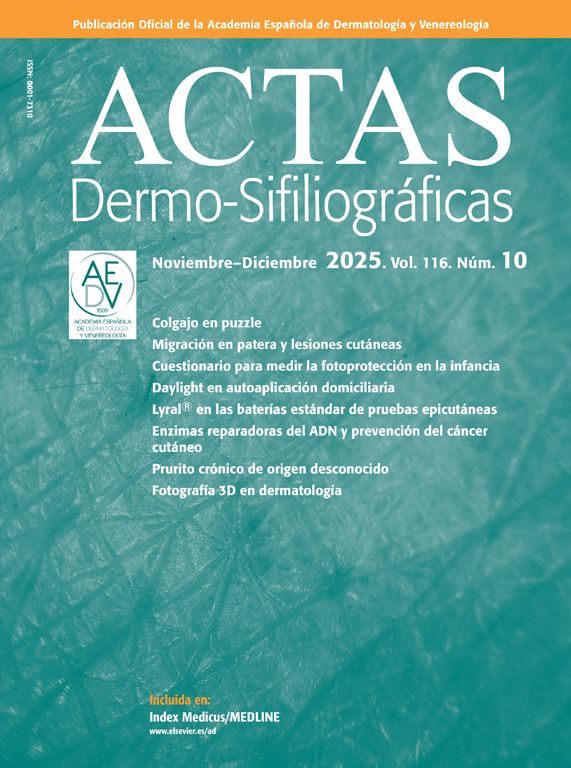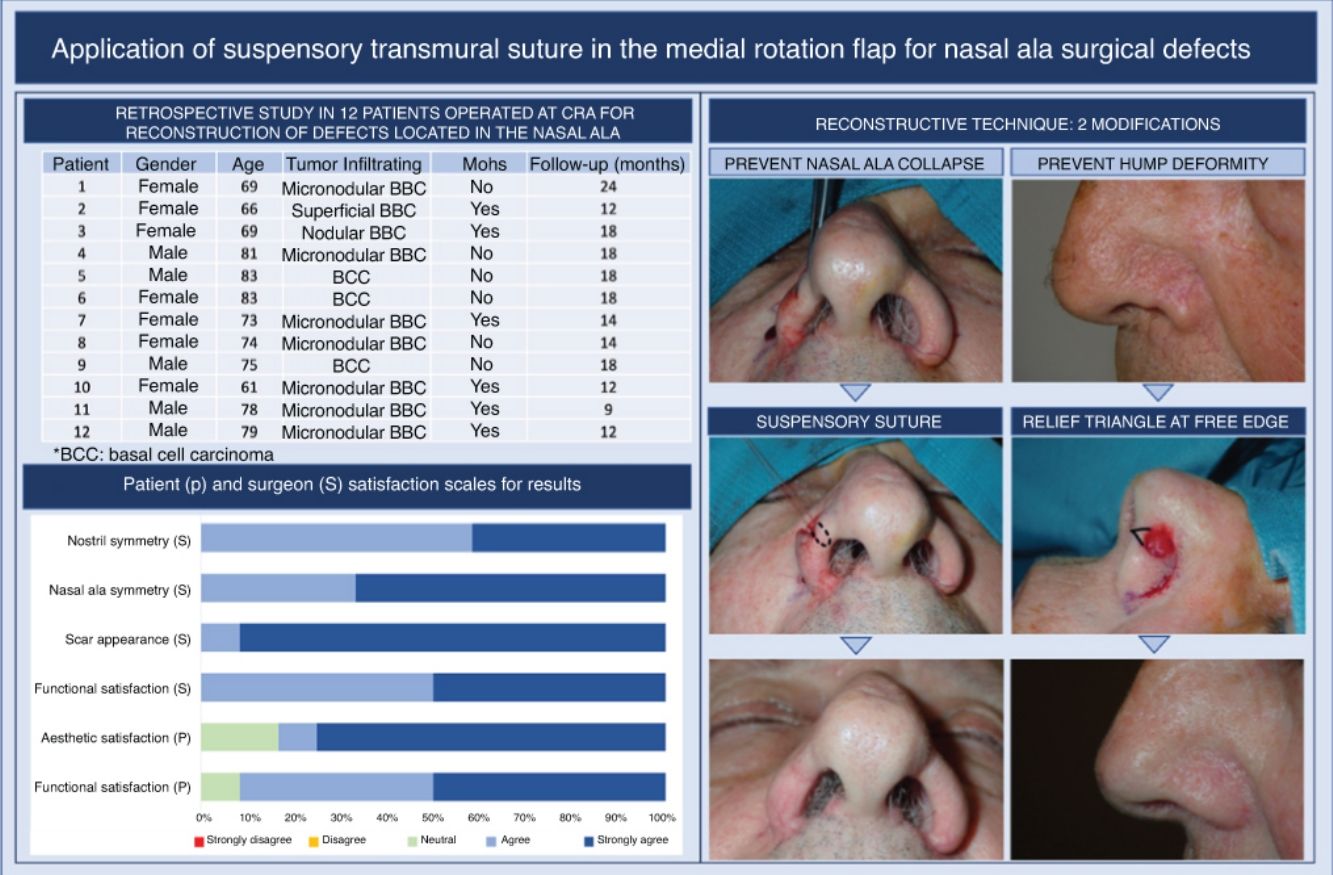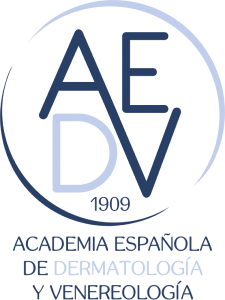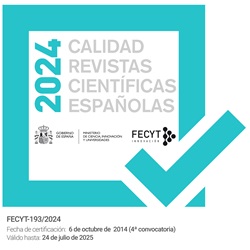Reconstructing the nasal pyramid presents a significant challenge due to its anatomical complexity and need to preserve the functionality of the internal nasal valve and maintain facial symmetry. This study provides a retrospective analysis of 12 cases in which an alar rotation flap was employed to reconstruct surgical defects in the nasal ala. It outlines the fundamental keys of the procedure and provides practical considerations aimed at preventing nose pincushioning and alar asymmetry. Functional and esthetic outcomes were assessed, revealing the absence of complications and high satisfaction scores at the follow-up, which adds to the objective evaluation of the results. These findings confirm the feasibility of the alar rotation flap as an effective and versatile option, especially to address small defects in the nasal ala. Additionally, we propose 2 strategies to improve functional and esthetic outcomes alike.
La reconstrucción de la pirámide nasal presenta un desafío significativo debido a su complejidad anatómica y la necesidad de preservar la funcionalidad de la válvula nasal interna y mantener la simetría facial. Presentamos un estudio retrospectivo de 12 casos en los que se empleó un colgajo de rotación alar para la reconstrucción de defectos quirúrgicos localizados en el ala nasal, describiendo las claves fundamentales del procedimiento y algunas consideraciones prácticas dirigidas a prevenir el estrechamiento de la narina y la asimetría alar. Por otro lado, se evaluaron los resultados funcionales y estéticos, revelando la ausencia de complicaciones y una alta satisfacción durante el seguimiento, lo cual aporta una valoración objetiva de los resultados. Estos hallazgos confirman la viabilidad del colgajo de rotación alar como una opción efectiva y versátil, especialmente para abordar pequeños defectos del ala nasal. Además, proponemos dos estrategias para mejorar tanto los resultados funcionales como estéticos.
The reconstruction of oncologic defects located in the nasal ala represents a true surgical challenge due to the significant functional and esthetic importance of this esthetic subunit.1 Among the various reconstructive options available, the alar rotation flap (ARF) is a reliable choice for reconstructing defects affecting less than one-third of the nasal ala. However, improper design or execution of this flap can lead to potential distortion of the ala and nasal vestibule.
We present a retrospective analysis of 12 surgical defects located in the nasal ala and reconstructed using an ARF, with surgical strategies implemented to achieve an optimal outcome.
Material and methodsPatientsWe conducted a retrospective observational study of adult patients who underwent oncologic surgery on the nasal ala followed by reconstruction using an ARF at Clínica Universidad de Navarra from 2020 to 2023. Clinicopathological variables were collected, as well as patient evaluations of esthetic and functional outcomes, and surgeon evaluations of functional satisfaction, scar appearance, alar symmetry, and nostril symmetry. Outcomes were assessed using a Likert scale ranging from 1 to 5 (1=unsatisfactory, 5=completely satisfactory) at 6 and 12 months. Patients gave their prior informed consent to participate in the study, which was approved by Clínica Universidad de Navarra ethics committee.
Surgical techniqueThe ARF reconstruction was performed using the following steps:
- 1.
Flap design: A curved line is drawn inferolaterally along the nasal alar groove from the superolateral edge of the remaining defect to the start of the nasolabial fold. Of note, this option is not suitable for defects involving the alar rim or nasal dorsum. In some cases, a back-cut triangle with an angle<30° is necessary in the inferior part of the surgical defect to prevent nostril narrowing.
- 2.
Flap creation: Using a scalpel, incisions are performed following the drawn design. The flap is then dissected and sculpted in the subcutaneous plane. It is crucial to ensure adequate flap thickness to avoid nasal orifice obstruction and ensure proper vascularization. Therefore, this technique should not be considered for patients with visible cutaneous atrophy in the area.
- 3.
Flap adaptation: Once the flap is sculpted, it must be adapted to the patient's anatomy. Before suturing, it is recommended to rotate the flap to confirm that there is no distortion of the nasal ala or nostril narrowing. In our experience, we observed the benefit of adding a suspensory transmural suture2,3 to anchor the deep dermis of the defect to its most lateral and superficial region (Fig. 1). This technique helps open the nasal ala and prevents nostril narrowing. Additionally, potential ala distortion forming a “hump” on the free margin must be considered. In such cases, it is necessary to extend the incision caudally and add a back-cut triangle toward the free edge4–6 (Fig. 2).
Figure 1.Alar rotation flap used for the surgical reconstruction of a defect located in the anterior third of the nasal ala. (a) Flap design; (b and c) mobilization and positioning of the flap. (d) Note the narrowing of the nostril upon flap mobilization. (e) Placement of a transmural suspension suture anchoring the base of the surgical defect to its superolateral border. (f) Nasal vestibule opening following placement of the suspension suture. (g and h) Immediate postoperative outcome. (i and j) Nasal orifice symmetry is maintained without vestibular collapse 2 months after surgery.
Figure 2.Reconstruction of a surgical defect on the nasal ala using an ARF. (a) Surgical defect following complete excision of a basal cell carcinoma. (b) Flap design. (c and d) Upon positioning and mobilizing the flap, a “hump” deformity is observed. (e and f) Closure of the defect after creating a back-cut triangle toward the free margin. (g–i) Note the absence of deformity after the back-cut triangle has been performed.
- 4.
Hemostasis and surgical defect closure: After confirming hemostasis, defect closure is performed. First, the superomedial corner of the flap is approximated to the superomedial corner of the surgical defect using a guiding subcutaneous suture (rapidly absorbable 5/0 monofilament). Afterwards, subcutaneous approximation of the medial and then lateral sides of the flap follows. Finally, the flap is sutured with non-absorbable 6/0 suture.
A total of 12 patients (5 men and 7 women) with a mean age of 74.2 years (range, 61–83) were included and underwent modified ARF reconstruction. All patients were treated for basal cell carcinoma—5 via Mohs surgery with a mean of 1.2 stages, and 7 via conventional surgery. The mean surgical defect size was 0.61cm×0.53cm, ranging from 0.8cm to 0.4cm×0.7cm to 0.3cm.
No postoperative complications (dehiscence, necrosis, bleeding, or infection) were observed in any of the patients. At the 12-month follow-up, no signs of local recurrence were noted, and all patients had favorable disease progression. Patient satisfaction scores averaged 4.41/5 for functional satisfaction and 4.6/5 for esthetic results. Surgeon assessments averaged 4.5/5 for functional satisfaction, 4.91/5 for scar appearance, 4.6/5 for alar symmetry, and 4.41/5 for nostril symmetry.
DiscussionThe nasal pyramid is considered an anatomically complex structure to reconstruct, both functionally and esthetically. The presence of cartilage and abundant fibroglandular tissue contributes to greater rigidity and limited mobility in this area.7,8
Despite the existence of numerous reconstructive options, the ARF is a versatile choice with a very simple design. It can be used for partial-thickness surgical defects located anywhere on the nasal ala, except when the alar rim or nasal dorsum is involved.9 Moreover, it is preferable for defects on the medial border to hide scars along the frontal edge of the ala.10 Importantly, to prevent nasal ala distortion, this technique is best used for defects involving less than one-third of the nasal ala. One of the main advantages of the ARF is that it allows the use of skin with similar characteristics to that of the defect, leading to excellent esthetic outcomes.11 Additionally, it is a random-pattern flap highly vascularized mainly by branches of the angular artery from the facial artery, which provides high viability with low necrosis rates.12
To preserve flap function and avoid any signs of nasal obstruction, proper selection of defect size and location is essential. However, this study proposes 2 additional strategies to help prevent airway obstruction when using this flap. Notably, despite the small size of some defects, some patients exhibit nostril narrowing upon flap placement. To prevent this narrowing and ensure airway patency, we propose a suspensory suture anchoring the defect base to the superficial dermis of the lateral defect.2,3 Additionally, it is essential to know that the ARF can create a “hump” deformity along the free edge, contributing to nasal obstruction symptoms. To prevent this deformity, we recommend extending the incision caudally and adding a back-cut triangle toward the nasal ala's free edge. In some cases, the incision may need to extend around the alar rim to reach the internal nasal mucosa.6
Other reconstructive options for nasal ala defects include transposition flaps such as the bilobed or rhomboid flap. These carry risks of flap bulging (trapdoor effect) and disruption of the alar groove. The paramedian forehead flap can also be a good option, though its complexity and need for at least 2 surgical stages make it preferable for complex full-thickness defects involving most of the nasal ala.13 Healing by second intention is another valid option, but healing times are usually longer. Additionally, in deep defects, it can result in depressed scars or excessive wound contraction, potentially compromising the nasal valves and causing nasal respiratory insufficiency.14 Finally, some authors also mention the benefits of full-thickness skin grafts for deep defects9,15; however, esthetic results are often less satisfactory, and for smaller defects, other alternatives can yield optimal outcomes.
Limitations of our study include its retrospective design and lack of long-term structured follow-up to properly assess tumor recurrence. However, the uniformity of the lesions in terms of location and size makes the advantages of this flap easily reproducible, demonstrating its satisfactory results.
ConclusionsThe ARF is an effective and versatile reconstructive option for addressing defects involving less than one-third of the nasal ala. In line with the literature, this study provides objective results on both esthetic and functional outcomes from the perspectives of patients and surgeons. Additionally, this study emphasizes the benefits of incorporating a back-cut triangle toward the free edge of the nasal ala to improve alar symmetry and prevent a “hump” effect. We also suggest the use of a suspensory suture to prevent nostril narrowing and, consequently, an obstructive effect on the nasal vestibule.
Conflicts of interestNone declared.









